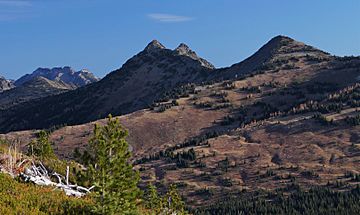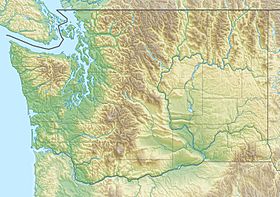Jackita Ridge facts for kids
Quick facts for kids Jackita Ridge |
|
|---|---|

Jackita Ridge seen from southwest
|
|
| Highest point | |
| Elevation | 7,350 ft (2,240 m) |
| Prominence | 1,270 ft (390 m) |
| Isolation | 3.50 mi (5.63 km) |
| Parent peak | Crater Mountain (8,128 ft) |
| Geography | |
| Location | North Cascades National Park Whatcom County, Washington, U.S. |
| Parent range | Hozameen Range North Cascades Cascade Range |
| Topo map | USGS Shull Mountain |
| Type of rock | greenstone |
| Climbing | |
| Easiest route | Scrambling |
Jackita Ridge is a tall mountain ridge in Washington state. It stands about 7,350 feet (2,240 meters) high. You can find it in the Pasayten Wilderness in Whatcom County.
This ridge is part of the Hozameen Range, which is a smaller part of the larger North Cascades mountains. The very top of the ridge is called Jackita Peak. There's a trail, the Jackita Ridge Trail, that goes along the side of this peak. Hikers can use this trail to get close and then climb to the very top.
Jackita Ridge has some interesting neighbors. Crater Mountain is about 3.9 miles (6.3 km) to the southwest. Jack Mountain is about 4.77 miles (7.68 km) to the west. And McKay Ridge is about 5.7 miles (9.2 km) to the south. Water from the ridge flows into Ross Lake through Devils Creek and Canyon Creek. These creeks are part of the Skagit River system. People think the first climb to the top might have been in 1926. This was when the U.S. National Geodetic Survey placed a special marker, called a Jackita benchmark, there.
Weather at Jackita Ridge
Jackita Ridge is in a special climate zone called the marine west coast climate. This means it gets a lot of moisture from the Pacific Ocean. This type of climate helps small glaciers form on the northern side of the ridge.
Most of the weather systems start over the Pacific Ocean. They then move northeast towards the Cascade Mountains. When these weather systems hit the tall peaks of the North Cascades, they are forced to rise. As the air rises, it cools down and drops its moisture. This process is called Orographic lift.
Because of this, the western side of the North Cascades gets a lot of rain or snowfall. Winters here are usually cloudy and very snowy. However, in the summer, high-pressure systems over the Pacific Ocean often bring clear skies. The snow in this area tends to be wet and heavy. This can make avalanches more likely. The best time to visit Jackita Ridge for hiking or sightseeing is usually from July to September. This is when the weather is most pleasant.
How Jackita Ridge Was Formed
The North Cascades mountains, where Jackita Ridge is located, have a very rugged landscape. You can see sharp peaks, long ridges, and deep valleys carved by glaciers. The amazing shapes of these mountains and the big changes in height happened over millions of years. These changes also led to different climates and types of plants in the area.
The Cascade Mountains started forming millions of years ago, during a time called the late Eocene Epoch. This happened because the North American Plate (a huge piece of Earth's crust) was slowly moving over the Pacific Plate. This movement caused many volcanic eruptions.
Also, small pieces of Earth's crust, called terranes, crashed into North America. These collisions helped build the North Cascades about 50 million years ago.
Later, over two million years ago, during the Pleistocene period, huge sheets of ice called glaciers moved across the land. They moved forward and then melted back many times. As they moved, they scraped and shaped the landscape. This left behind piles of rock and created the "U"-shaped valleys you see today. The mountains also continued to rise up (uplift) and crack (faulting). These processes, along with the glaciers, created the tall peaks and deep valleys of the North Cascades.



